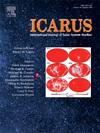Insights into pyroxene-dominated surfaces and implications for ongoing space exploration missions
IF 2.5
2区 物理与天体物理
Q2 ASTRONOMY & ASTROPHYSICS
引用次数: 0
Abstract
Ungrouped achondrites are differentiated (melted) meteorites that do not fit into any known meteorite group because of their unusual mineralogies and/or oxygen isotopic compositions; their asteroidal or planetary origins are unknown. Two recently discovered samples, Northwest Africa 15915 (NWA 15915) and Ksar Ghilane 022 (KG 022), have mineral assemblages not previously identified in meteorites, consisting of iron-free silicates (including augite, enstatite, and olivine) and unusual sulphides (such as oldhamite). These samples offer the opportunity to probe the spectral properties of mineralogically distinct surfaces. NWA 15915 and KG 022 have oxygen isotopic compositions in the field of enstatite chondrites and aubrites, a near absence of spectral features in the visible and near-infrared, and a similar mineralogy to that which is expected for the surface of Mercury. While it is unlikely that the two meteorites are fragments of Mercury, they may be good analogs for Mercury's surface on a regional scale. ESA/JAXA's BepiColombo will provide an exceptional opportunity to compare the composition of differing mineralogical units on Mercury with samples such as NWA 15915 and KG 022.
深入了解辉石岩为主的地表及其对正在进行的太空探索任务的影响
未分组的无球粒陨石是已分化(熔化)的陨石,由于其不寻常的矿物学和/或氧同位素组成而不属于任何已知的陨石群;它们的小行星或行星起源是未知的。最近发现的两个样品,西北非洲15915 (NWA 15915)和Ksar Ghilane 022 (KG 022),具有以前未在陨石中发现的矿物组合,由不含铁的硅酸盐(包括奥辉石、顽辉石和橄榄石)和不寻常的硫化物(如oldhamite)组成。这些样品提供了探测矿物学上不同表面的光谱特性的机会。NWA 15915和KG 022在顽辉石球粒陨石和火长辉石领域具有氧同位素组成,在可见光和近红外波段几乎没有光谱特征,并且与水星表面的矿物学相似。虽然这两颗陨石不太可能是水星的碎片,但在区域范围内,它们可能是水星表面的很好的类似物。ESA/JAXA的BepiColombo将提供一个难得的机会,将水星上不同矿物学单位的组成与NWA 15915和KG 022等样品进行比较。
本文章由计算机程序翻译,如有差异,请以英文原文为准。
求助全文
约1分钟内获得全文
求助全文
来源期刊

Icarus
地学天文-天文与天体物理
CiteScore
6.30
自引率
18.80%
发文量
356
审稿时长
2-4 weeks
期刊介绍:
Icarus is devoted to the publication of original contributions in the field of Solar System studies. Manuscripts reporting the results of new research - observational, experimental, or theoretical - concerning the astronomy, geology, meteorology, physics, chemistry, biology, and other scientific aspects of our Solar System or extrasolar systems are welcome. The journal generally does not publish papers devoted exclusively to the Sun, the Earth, celestial mechanics, meteoritics, or astrophysics. Icarus does not publish papers that provide "improved" versions of Bode''s law, or other numerical relations, without a sound physical basis. Icarus does not publish meeting announcements or general notices. Reviews, historical papers, and manuscripts describing spacecraft instrumentation may be considered, but only with prior approval of the editor. An entire issue of the journal is occasionally devoted to a single subject, usually arising from a conference on the same topic. The language of publication is English. American or British usage is accepted, but not a mixture of these.
 求助内容:
求助内容: 应助结果提醒方式:
应助结果提醒方式:


